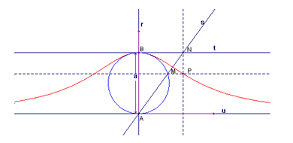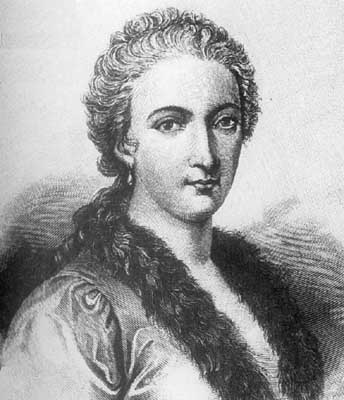Biography
Maria Gaetana Agnesi was born in Milan on May 16, 1718. She was the daughter of Pietro Agnesi Mariami and Anna Brivio. In her country, unlike in other European countries, women were allowed to receive an education, and so she had a thorough training. She was a precocious, talented child; at the age of five, she spoke French and when she was nine, she spoke seven languages: Italian, Latin, French, Greek, Hebrew, German and Spanish, and was referred to as the "Seven-Tongued Orator".
Maria was the eldest of 21 siblings. Her father resolved to give his children the best education possible, including scientific training, and found the most qualified tutors for them. She studied Reyneau's Analyse demontrée (1708) as well as the mathematics of de Fermat, Descartes, Newton, Leibniz, Euler and the Bernoullis.
At the age of nine, Maria spoke in Latin for an hour, before a cultured audience, about the women's right to study science and how liberal arts were not opposed to the female sex. Maria was able to speak about and discuss many topics in different languages.
When she was 17, she made a relevant critique of Guillaume François de l’Hôpital's treatise on conics, Traité analytique des sections coniques, which was never published, but it was widely spread in private.
In 1738, she published Propositiones Philosophicae, a complete collection of 190 works in Latin on natural science and philosophy which includes information on logic, mechanics, hydraulics, elasticity, chemistry, botany, zoology, mineralogy, astronomy, philosophy, celestial mechanics and Newton's law on universal gravitation.
Maria never married. In 1739, she wanted to join a convent. Since her father disapproved, she did not, but she rejected public life and led an isolated, pious life. At the request of her father, she decided to stay home and focused on studying books on religion and mathematics.
Her most important work, Instituzioni analitiche ad uso della gioventú italiana, had two volumes. The first one was about the contemporary information on algebra and analytic geometry. It was published in 1748. The second one, published a year later, was about the new knowledge on differential and integral calculus, the subject that was being studied at the time.
It was the first text written to study both differential and integral calculus, which also tackled infinite series and differential equations. It included many examples and carefully selected problems to illustrate ideas, original methods and generalisations. She had started writing it as a distraction, but it then became a manual for her younger siblings and, in the end, a relevant publication.
It was remarkably received. The report of a commission of the Paris Academy of Sciences stated: "This work is characterised by being carefully organised, clear and precise. There is no book, in any other language, that allows the reader to delve so deeply or so quickly into the fundamental concepts of analysis. We consider this treatise as the most thorough and the best written in its genre." Said commission, which decided to translate and publish the work in French, was made up of important mathematicians: D’Alembert, Condorcet and Vandermonde. It was translated into several languages and used as a manual at universities in many countries; fifty years later, it was still the most thorough mathematical text.
The Instituzioni had a great impact on education, since they harmonised, in a single text, diverse and heterogeneous materials from previous mathematicians. For the first time, information was arranged following a logical and educational sequence from algebra to differential equations.
She dedicated the book to Empress Maria Theresa, the ruler of Milan, who in turn compensated her. Pope Benedict XIV gave Agnesi a gold medal and a crown with precious gems.
In 1750, the Pope designated her professor of Advanced Mathematics and Natural Philosophy at University of Bologna, which belonged to the Papal States at the time. During that period, Maria led a pious, private life, and she never actually went to Bologna, but her name remained in the university registry for forty-five years. She was appointed member of the Bologna Academy of Sciences.
After her father died when she was 34, she gave up mathematics and consecrated her efforts to studying theology, helping the poor and the homeless, and educating her siblings. From 1771 on, she was director of the Trivulzio Hospice in Milan. She devoted her life to charitable work while living in poverty, since she gave her fortune to the poor. She died in the institution she directed on January 9, 1799.
Maria was a renowned mathematician in her time. However, her historical reputation was distorted due to the fact that, in her Instituzioni Analitiche she discussed a kind of curve described as versiera, which in Italian means 'to turn', 'to veer'. When translating the work, John Colson mixed up the terms versiera and avversiera, which means 'she-devil', 'witch'. Due to that error, the curve was then named "witch of Agnesi" and so is Maria by association.
This curve was discussed by Fermat in 1703. It has been recently established that it is an approximation of the distribution of X-rays and optical rays energy spectrum, as well as dissipated power in high-frequency resonance circuits.
The equation for the curve is:
Its graph is:

Extracted from Mujeres con ciencia (01/04/2022) https://mujeresconciencia.com/2017/07/11/maria-gaetana-agnesi-1718-1799/
Extracted from Wikipedia (04/01/2022) https://es.wikipedia.org/wiki/Mar%C3%ADa_Gaetana_Agnesi

